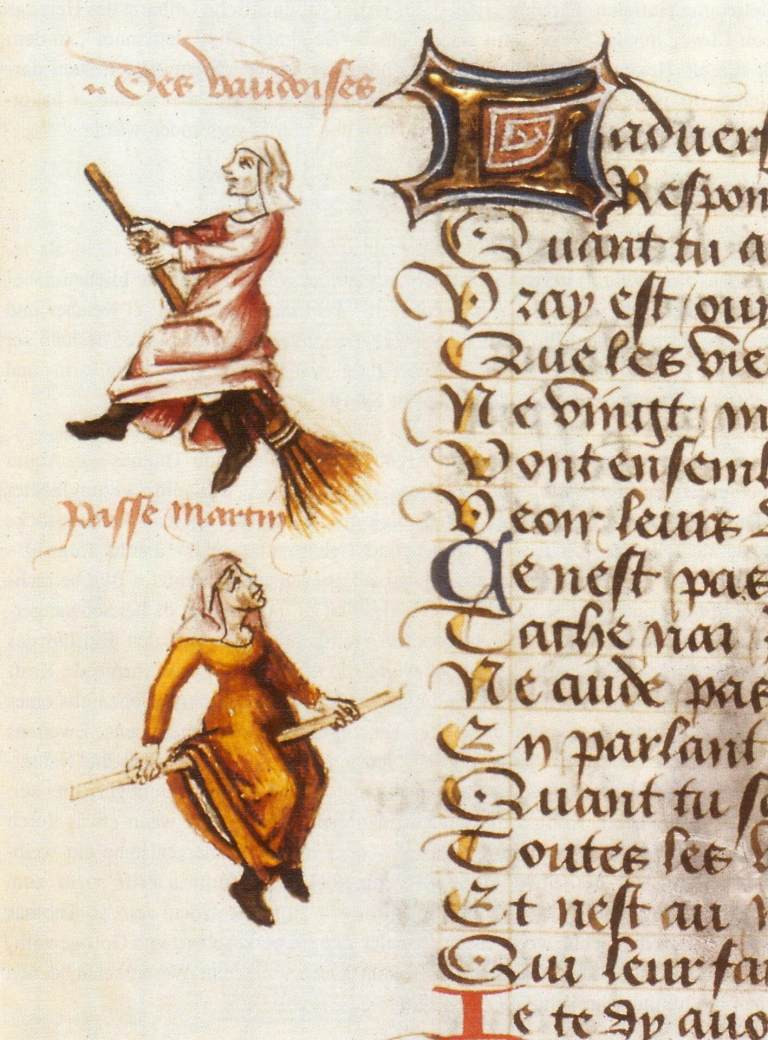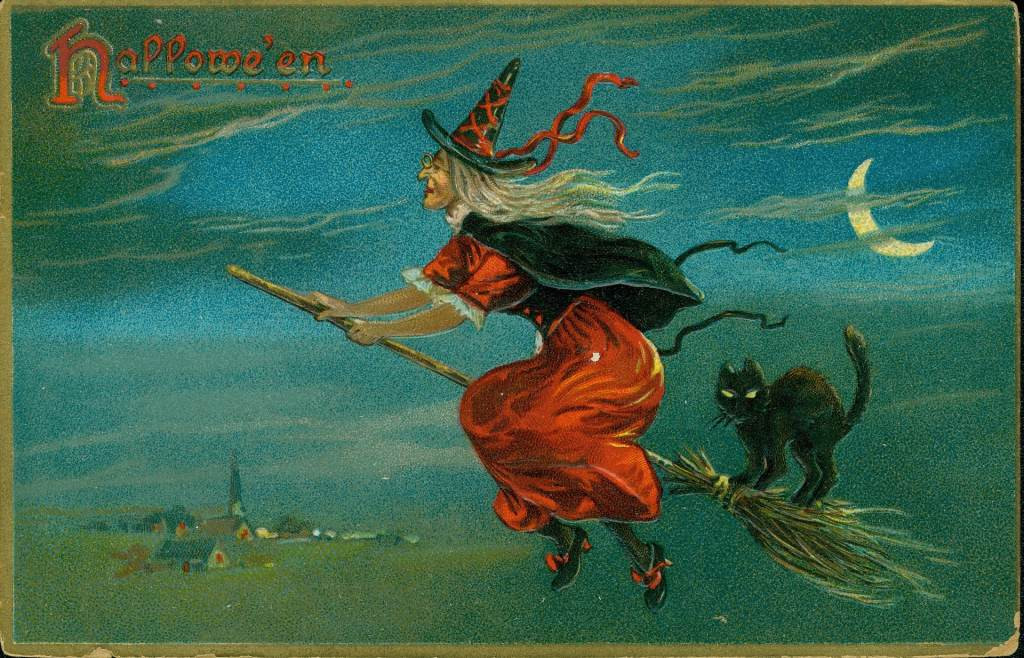Where Did Witches Flying On Broomsticks Come From? The image of a witch soaring through the night sky on a broomstick is iconic, deeply embedded in our collective imagination. At flyermedia.net, we will unravel the fascinating history and symbolism behind this enduring image, exploring its roots in pagan rituals, social anxieties, and artistic interpretations. Learn how women took to the skies in a most unusual way.
1. What Is The Origin Of The Witch Broomstick Trope?
The origin of the witch broomstick trope lies in a combination of pagan rituals, symbolic meanings, and social anxieties. These elements coalesced over centuries to create the enduring image we know today. It’s a mix of historical practices and cultural interpretations that paints the witch as a figure of both fear and fascination.
Pagan Roots
Pagan rituals played a significant role in the broomstick’s association with witchcraft. Reginald Scot’s 1584 book, The Discoverie of Witchcraft, describes pagan fertility rituals where participants danced with brooms held aloft. This act was intended to bless crops and ensure a bountiful harvest. The broom, therefore, was a symbol of fertility and connection to the natural world, core aspects of pagan beliefs.
Symbolic Meanings
Broomsticks carried symbolic weight beyond their agricultural associations. They were seen as both phallic symbols and emblems of domesticity. In a patriarchal society, a “proper” woman was expected to keep her home clean. Thus, the broom represented both a woman’s adherence to societal norms and a potential subversion of them. Embracing sexuality, especially in a repressed era, was controversial, and the broomstick became a symbol of this defiance. According to Atlas Obscura, witches were not always seen as magical beings but their broomsticks did have a lot of symbolic meaning.
Social Anxieties
The association of women with broomsticks also reflected social anxieties about female power and independence. Accusations of witchcraft often targeted women who deviated from societal expectations. By associating these women with broomsticks and nocturnal flight, society could demonize and control them. The broomstick became a tool for discrediting and marginalizing those who didn’t conform.
2. When Was The First Depiction Of A Witch On A Broomstick?
The first known depiction of a witch on a broomstick appears in Martin Le Franc’s 1451 book Le Champion des Dames. This illustration features a woman riding a broomstick, solidifying the association between witches and this mode of transport. It’s the earliest visual representation of this iconic image.
“Le Champion Des Dames”
Martin Le Franc’s Le Champion des Dames includes an image of two women, one of whom is riding a broomstick. This depiction marks a pivotal moment in the history of witchcraft imagery. While the mystical connotations are not explicitly stated, the image establishes the broomstick as a vehicle for women, contributing to its later association with witches.
 Le Champion des Dames
Le Champion des Dames
Significance Of The Depiction
This early depiction is significant because it predates many of the widespread witch trials and persecutions of the later centuries. It suggests that the association between women and broomsticks was already present in the cultural imagination. The image likely drew upon existing folklore and beliefs, contributing to the development of the witch stereotype.
Interpretations Of The Image
Interpretations of the image in Le Champion des Dames vary. Some scholars believe the broomstick is simply a mundane object, while others see it as a symbol of female power or sexuality. Regardless of the intended meaning, the image played a crucial role in shaping the visual representation of witches in art and literature.
3. How Did The Salem Witch Trials Influence The Image Of Witches?
The Salem Witch Trials, which took place in colonial Massachusetts in 1692, solidified the image of witches as malevolent figures. While the accused “witches” did not actually fly on broomsticks, the trials contributed to the association of witchcraft with fear, superstition, and female deviance. The trials amplified existing stereotypes and cemented them in the popular imagination.
The Salem Witch Trials
The Salem Witch Trials were a series of hearings and prosecutions of people accused of witchcraft in colonial Massachusetts. Fueled by religious extremism, social anxieties, and personal vendettas, the trials resulted in the execution of nineteen innocent people. The events in Salem left an indelible mark on American history and continue to fascinate and horrify us today.
Impact On Witch Stereotypes
The Salem Witch Trials reinforced the stereotype of witches as evil, conniving women who threatened the social order. Accusations of witchcraft often targeted women who were independent, outspoken, or simply different. The trials served to silence and control women who did not conform to societal expectations.
Broomsticks In The Salem Context
While there is no evidence that the accused witches in Salem actually flew on broomsticks, the trials contributed to the association of witchcraft with magical powers and supernatural abilities. The image of the witch flying on a broomstick became a symbol of her supposed ability to defy the laws of nature and harm others.
4. What Role Did Paganism Play In Connecting Witches To Broomsticks?
Paganism played a crucial role in connecting witches to broomsticks by providing a foundation of rituals, beliefs, and symbols. Pagan traditions celebrated the natural world and fertility, and the broomstick became associated with these themes. The connection between witches and broomsticks is deeply rooted in pagan practices.
Pagan Beliefs And Practices
Paganism encompasses a wide range of beliefs and practices that emphasize the interconnectedness of all things. Pagan traditions often involve honoring nature, celebrating seasonal cycles, and seeking spiritual connection through ritual and ceremony. Fertility rituals were particularly important in ensuring the continuation of life and the abundance of resources.
Broomsticks As Fertility Symbols
In pagan rituals, broomsticks were used as fertility symbols. They were carried through fields to promote bountiful harvests and were associated with the feminine energy of the earth. The broomstick represented the power of women to create and nurture life.
Witchcraft And Paganism
Witchcraft, as it developed in Europe, drew upon many pagan beliefs and practices. Witches were seen as practitioners of magic who could harness the power of nature for good or ill. The broomstick became a tool for witches, both literally and symbolically, representing their connection to the earth and their ability to influence the world around them.
5. How Did Early Modern Europe Contribute To The Witch On A Broomstick Image?
Early Modern Europe, a period marked by religious upheaval, social unrest, and intellectual ferment, significantly contributed to the witch on a broomstick image. During this time, witch hunts became widespread, and the image of the witch was increasingly demonized. The broomstick became a symbol of the witch’s supposed ability to engage in nocturnal flights and attend sabbats.
Witch Hunts In Europe
The witch hunts of Early Modern Europe were a dark chapter in history. Thousands of people, mostly women, were accused of witchcraft and subjected to torture, imprisonment, and execution. The witch hunts were fueled by religious paranoia, social anxieties, and the belief that witches posed a threat to the Christian community.
Nocturnal Flights And Sabbats
One of the key beliefs about witches during this period was that they could fly through the night on broomsticks or other objects to attend sabbats. Sabbat were secret meetings where witches were said to engage in orgies, worship the Devil, and plot against humanity. The broomstick became inextricably linked to these imagined activities.
The Demonization Of Witches
The witch hunts led to the demonization of witches in popular culture. Witches were portrayed as ugly, malevolent figures who possessed supernatural powers and used them for evil purposes. The broomstick became a symbol of their wickedness and their ability to defy the laws of God and nature.
6. What Are Some Of The Sexual Connotations Associated With Witches And Broomsticks?
Some of the sexual connotations associated with witches and broomsticks stem from the broomstick’s phallic shape and its connection to fertility rituals. In a repressed society, the broomstick became a symbol of female sexuality and the supposed promiscuity of witches. The association of witches with sexuality has been a persistent theme in art and literature.
Phallic Symbolism
The broomstick’s phallic shape is an obvious source of its sexual connotations. In a patriarchal society, the phallus is often associated with power and dominance. By associating witches with a phallic symbol, society may have been attempting to assert control over female sexuality.
Fertility Rituals
As mentioned earlier, broomsticks were used in pagan fertility rituals. These rituals often involved sexually suggestive acts and were intended to promote the growth of crops and the continuation of life. The association of broomsticks with fertility reinforced their connection to sexuality.
Witchcraft And Promiscuity
During the witch hunts, witches were often accused of promiscuity and sexual deviance. These accusations were used to justify their persecution and to portray them as a threat to the social order. The broomstick became a symbol of their supposed sexual immorality.
7. How Have Modern Interpretations Of Witches And Broomsticks Evolved?
Modern interpretations of witches and broomsticks have evolved significantly from the demonized image of the past. Today, witches are often portrayed as empowered women who embrace their sexuality and their connection to nature. The broomstick has become a symbol of their independence and their ability to defy societal norms.
Witches As Empowered Women
In contemporary culture, witches are often celebrated as symbols of female empowerment. They are seen as women who challenge patriarchal structures and embrace their own unique identities. The image of the witch has been reclaimed by feminists and other activists as a symbol of female strength and resilience.
Broomsticks As Symbols Of Independence
The broomstick has also been reinterpreted as a symbol of independence. It represents the witch’s ability to travel freely and to defy the constraints of society. The broomstick is no longer seen as a tool of evil but as a symbol of liberation.
Popular Culture Representations
Popular culture has played a significant role in shaping modern interpretations of witches and broomsticks. In movies, television shows, and books, witches are often portrayed as complex characters with both strengths and weaknesses. The broomstick is often depicted as a magical object that allows them to fly, cast spells, and connect with the spirit world.
8. What Is The Relationship Between Witches, Broomsticks, And The Natural World?
The relationship between witches, broomsticks, and the natural world is one of deep connection and reverence. Witches are often portrayed as practitioners of magic who draw their power from nature. The broomstick, made from natural materials, symbolizes this connection and allows witches to travel through the natural world with ease.
Witches And Nature
Witches are often depicted as living in harmony with nature. They understand the cycles of the seasons, the properties of plants, and the power of the elements. They use their knowledge of nature to heal, protect, and create change in the world.
Broomsticks As Natural Objects
Broomsticks are traditionally made from natural materials such as wood, straw, and twigs. These materials connect the broomstick to the earth and to the natural world. The broomstick is not just a tool for transportation but a symbol of the witch’s connection to nature.
Magic And The Natural World
The magic that witches practice is often seen as an extension of the natural world. Witches use natural ingredients in their spells and rituals, and they often invoke the spirits of nature to help them achieve their goals. The broomstick allows witches to move through the natural world and to connect with its magical energies.
9. How Does The Harry Potter Series Use The Broomstick Trope?
The Harry Potter series uses the broomstick trope in a unique and imaginative way, transforming it into a symbol of both magical ability and sporting prowess. In the world of Harry Potter, broomsticks are not just for witches but for wizards as well, and they are used for transportation, recreation, and competition.
Quidditch
Quidditch, the iconic sport of the Harry Potter series, is played entirely on broomsticks. Players fly through the air, chasing balls and scoring points. The broomstick becomes an extension of the player’s body, allowing them to perform acrobatic feats and compete at high speeds.
Magical Transportation
In the Harry Potter series, broomsticks are a common mode of transportation for witches and wizards. They can be used to travel short distances or to fly across entire countries. The broomstick allows witches and wizards to move freely and to escape the Muggle world.
Symbolism In Harry Potter
The broomstick in Harry Potter carries multiple layers of symbolism. It represents magical ability, athleticism, and freedom. It is a symbol of the wizarding world and its unique culture.
10. What Are Some Modern Interpretations Of The Witch Flying On A Broomstick?
Modern interpretations of the witch flying on a broomstick vary widely, ranging from feminist symbols to Halloween costumes. The image of the witch on a broomstick has been reclaimed and reinterpreted in countless ways, reflecting the diverse perspectives and values of contemporary society.
Feminist Symbol
For some, the witch on a broomstick is a feminist symbol, representing female empowerment and resistance to patriarchal norms. The witch’s ability to fly through the air symbolizes her freedom from societal constraints and her ability to defy expectations.
Halloween Costume
For others, the witch on a broomstick is simply a fun and festive Halloween costume. The image is associated with spooky decorations, trick-or-treating, and the celebration of all things magical and mysterious.
Pop Culture Icon
The witch on a broomstick has become a pop culture icon, appearing in movies, television shows, books, and video games. The image is often used to evoke a sense of wonder, excitement, and the possibility of magic in the world.
 witch riding broomstick
witch riding broomstick
FAQ
- Why are witches associated with broomsticks?
Witches are associated with broomsticks due to a combination of pagan rituals, symbolic meanings, and social anxieties. Broomsticks were used in fertility rituals and became symbols of female sexuality and independence. - When did the association between witches and broomsticks begin?
The association between witches and broomsticks can be traced back to at least the 15th century, with the earliest known depiction appearing in Martin Le Franc’s 1451 book Le Champion des Dames. - What role did the Salem Witch Trials play in the image of witches?
The Salem Witch Trials solidified the image of witches as malevolent figures, reinforcing stereotypes of evil, conniving women who threatened the social order. - How did paganism influence the connection between witches and broomsticks?
Paganism connected witches and broomsticks through fertility rituals, where broomsticks were used as symbols of bountiful harvests and feminine energy. - What is the significance of broomsticks in modern interpretations of witchcraft?
In modern interpretations, broomsticks have been reinterpreted as symbols of independence, representing a witch’s ability to defy societal constraints and travel freely. - Are there sexual connotations associated with witches and broomsticks?
Yes, broomsticks have sexual connotations due to their phallic shape and connection to fertility rituals. They became symbols of female sexuality and promiscuity in repressed societies. - How does the Harry Potter series portray broomsticks?
The Harry Potter series portrays broomsticks as essential for magical transportation, recreation, and the iconic sport of Quidditch, symbolizing magical ability, athleticism, and freedom. - What are some modern interpretations of the witch flying on a broomstick?
Modern interpretations include the witch on a broomstick as a feminist symbol, a Halloween costume, and a pop culture icon, reflecting diverse perspectives and values. - How do witches, broomsticks, and the natural world relate?
Witches have a deep connection with nature, drawing power from it, and broomsticks, made from natural materials, symbolize this connection and allow witches to travel through the natural world easily. - What are the origins of the broomstick as a witch’s mode of transportation?
The origins lie in a mix of pagan rituals, symbolic meanings (like fertility and domesticity), and social anxieties about female power, evolving over centuries into the iconic image.
Conclusion
The image of the witch flying on a broomstick is a complex and fascinating one, rooted in history, folklore, and cultural imagination. From its origins in pagan rituals to its modern interpretations as a feminist symbol, the witch on a broomstick continues to captivate and inspire us. At flyermedia.net, we invite you to explore the many facets of this enduring image and to discover the magic and mystery that lies within.
Are you fascinated by flight and the mysteries of the sky? Do you dream of soaring through the air like the witches of legend? Then flyermedia.net is your ultimate destination. Whether you’re seeking information about flight training, aviation news, or career opportunities in the aerospace industry, we have everything you need to fuel your passion. Visit flyermedia.net today and take your first step towards a future filled with adventure and discovery.
Address: 600 S Clyde Morris Blvd, Daytona Beach, FL 32114, United States.
Phone: +1 (386) 226-6000.
Website: flyermedia.net.
